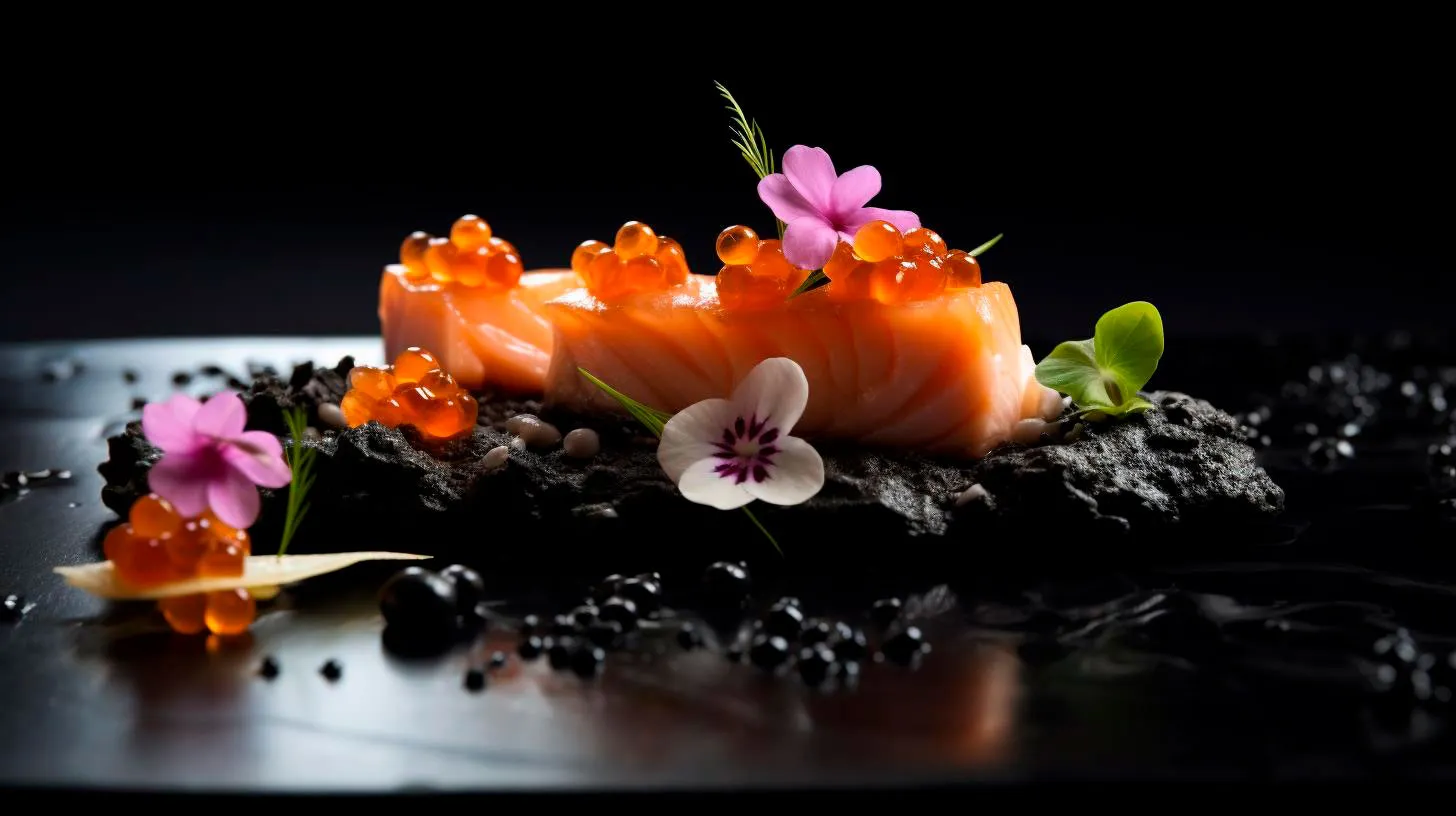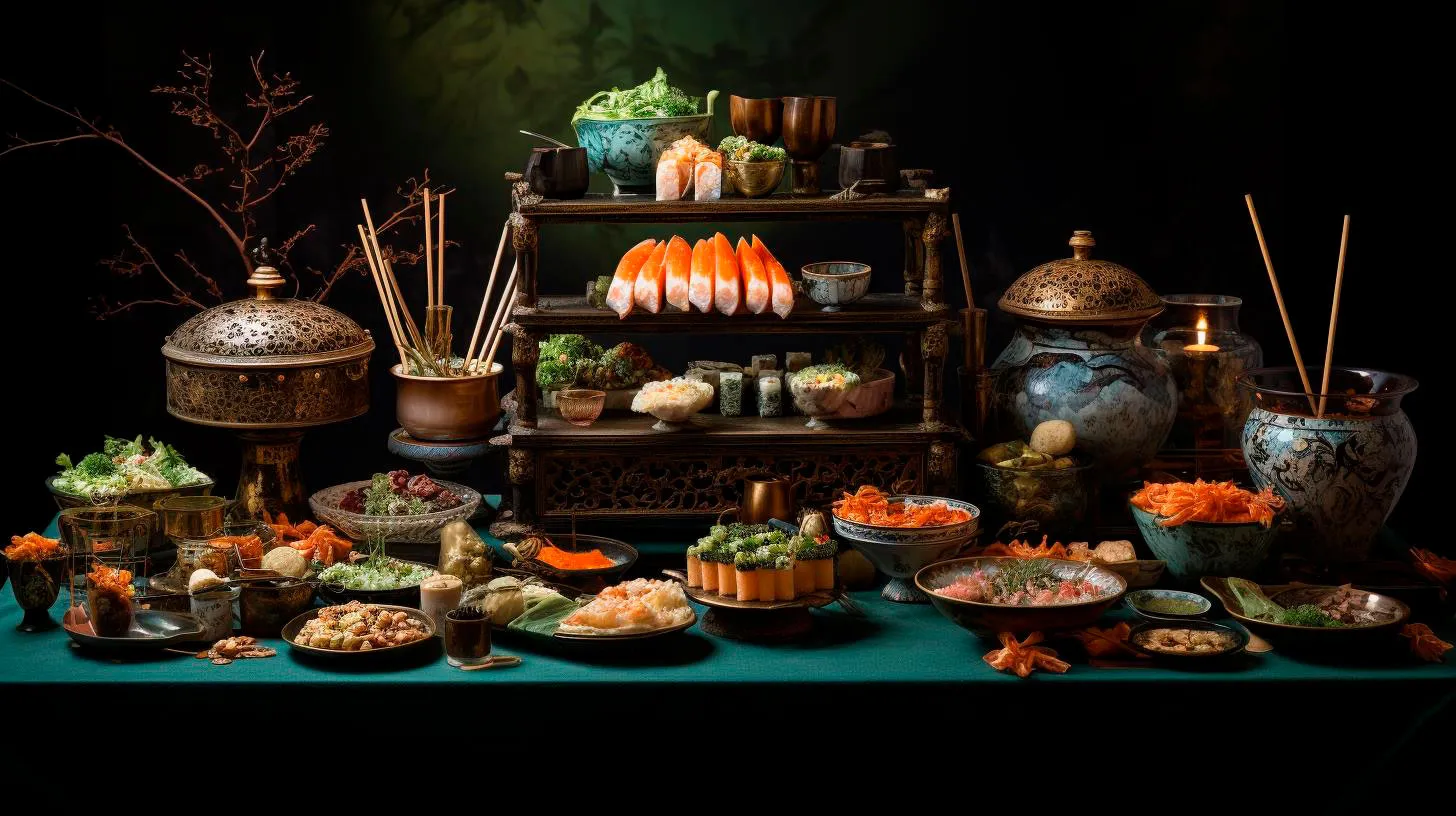The Artistry Behind Sushi: A Fusion of Flavor and Aesthetics
The artistry behind sushi lies in the delicate fusion of flavor and aesthetics, combining culinary skills with creative design. In this article, we will delve into the fascinating world of sushi, exploring its origins, techniques, and the mastery involved in crafting this culinary masterpiece.
The Origins of Sushi
Sushi dates back to ancient times and has evolved throughout Japanese history. In the 8th century, sushi emerged as a preservation method for fish. The fish was fermented with rice, creating a sour taste and prolonging its shelf life. This early form of sushi, known as narezushi, laid the foundation for the development of sushi as we know it today.
Over time, sushi evolved from a preservation method to a delectable delicacy. In the 19th century, a chef named Hanaya Yohei revolutionized sushi by introducing nigiri sushi, the style of sushi commonly seen today. Nigiri sushi consists of a small mound of vinegared rice topped with a slice of fresh fish or other seafood.
Today, sushi has become a global phenomenon, with countless variations and creative interpretations enjoyed by people worldwide.
The Sushi-Making Process
The artistry of sushi lies not only in the flavors and ingredients used but also in the precision and technique required to craft each piece. A skilled sushi chef, known as an itamae, undergoes years of training and apprenticeship to master this culinary art form.
Here is a step-by-step breakdown of the sushi-making process:
- Preparation: The chef starts by meticulously selecting the freshest and highest quality ingredients, including fish, seafood, vegetables, and rice. The rice, known as sushi rice, is specially seasoned with a mixture of rice vinegar, sugar, and salt.
- Slicing: The itamae expertly slices the fish or seafood, taking into consideration factors such as the texture, flavor, and appearance. The precision of each slice is crucial in achieving the perfect balance of flavors and textures.
- Shaping: The chef then shapes the sushi rice into neat, bite-sized mounds using their hands. The rice must be compact and evenly formed, providing a solid base for the toppings.
- Garnishing: The itamae adds a variety of garnishes to enhance the presentation and flavor of the sushi. This can include wasabi, pickled ginger, soy sauce, or other condiments.
- Plating: The final step is arranging the sushi on a plate, paying careful attention to color, texture, and balance. The itamae uses their artistic flair to create visually stunning arrangements that are as pleasing to the eye as they are to the palate.
The Art of Presentation
One of the most captivating aspects of sushi is its stunning presentation. The itamae’s attention to detail and artistic vision come to life through the arrangement of each piece. The colors, textures, and shapes are carefully considered to create a harmonious composition on the plate.
Bullet points:
- Colorful and visually appealing arrangements
- Use of fresh and seasonal ingredients enhances the aesthetic appeal
- Delicate balance of textures: soft, crunchy, smooth
- Intricate garnishes and decorations add an artistic touch
The presentation of sushi is often as important as its taste. The visual appeal entices the senses and builds anticipation for the culinary experience that awaits.
The Harmonious Fusion of Flavor and Aesthetics
Sushi is not only a treat for the eyes but also a delight for the taste buds. The fusion of flavor and aesthetics is at the very heart of this culinary art form. Each bite of sushi offers a unique combination of tastes and textures, carefully crafted to create a harmonious balance.
Key takeaways:
- Umami, the fifth taste, is a prominent characteristic of sushi
- Freshness and quality of ingredients contribute to the richness of flavors
- Contrasting flavors, such as sweet and savory or tangy and mild, create complexity
- The delicate balance of textures adds depth to the overall experience
Whether it’s the buttery smoothness of a slice of fatty tuna or the crisp bite of a vegetable roll, each piece of sushi is meticulously crafted to deliver a sensory experience like no other.
The Cultural Significance
Sushi not only represents the artistry of culinary craftsmanship but is also deeply intertwined with Japanese culture. It reflects the country’s dedication to precision, simplicity, and respect for nature. In Japan, sushi is not just a meal; it is an expression of harmony, balance, and appreciation for the beauty of the natural world.
In recent years, sushi has gained immense popularity globally, transcending cultural boundaries and captivating the hearts of food enthusiasts everywhere.
Conclusion
Sushi is much more than a dish; it is a testament to the creativity and skill of the sushi chef. The artistry behind sushi lies in its fusion of flavor and aesthetics, creating an unforgettable dining experience. From its humble origins to its present-day global popularity, sushi continues to captivate and inspire with its unique blend of taste, texture, and artistry.
Next time you savor a piece of sushi, take a moment to appreciate the intricate craftsmanship and the exquisite beauty before indulging in the explosion of flavors.
The Culinary Canvas: Savoring the Visual Delights of Sushi
In this article, we delve into the artistry behind sushi, exploring its visual appeal, creative presentation techniques, and the importance of aesthetics in Japanese cuisine.
The Artistry of Sushi:
Sushi is more than just a meal; it is a masterpiece that delights the eyes before it even reaches the palate. The meticulous craftsmanship displayed in the preparation and presentation of sushi makes it a true work of art. Here are some key elements that contribute to the visual appeal of sushi:
- Colorful Ingredients: Sushi is like a painting on a plate, with its vibrant and varied colors. From the rich hues of maguro (tuna) to the bright orange of ikura (salmon roe), each ingredient is carefully selected to create a visually captivating dish.
- Textural Contrasts: Sushi showcases an array of textures, from smooth and velvety slices of sashimi to the crunch of tempura flakes. These textural variations not only enhance the taste but also add visual interest to the overall presentation.
- Artful Arrangement: Sushi chefs take great pride in arranging the different components of a sushi roll or nigiri with precision and creativity. The placement of ingredients, such as thinly sliced vegetables or delicate garnishes, contributes to the aesthetic appeal of each dish.
The Importance of Aesthetics:
In Japanese cuisine, aesthetics play a vital role, and sushi is no exception. The visual presentation of sushi is considered as important as its taste, as it adds an extra dimension to the dining experience. Here’s why aesthetics matter in sushi:
- Tantalizing the Senses: Attractive presentation stimulates not only the sense of taste but also the sense of sight. When sushi is beautifully arranged, it enhances the anticipation and enjoyment of the meal. The visual experience complements the flavors, elevating the overall dining experience.
- Reflecting Nature and Seasons: Japanese culture is deeply rooted in the appreciation of nature and the changing seasons. Sushi plating often incorporates elements inspired by nature, such as using edible flowers, seaweed, or bamboo leaves. This connection to nature adds a sense of harmony and tranquility to the dining experience.
- Instagram-Worthy Presentation: In the era of social media, visually appealing dishes have become highly popular. Sushi’s visual allure makes it a favorite subject for food photography, making it a perfect fit for Instagram feeds and food blogs. The camera-ready nature of sushi makes it shareable and has contributed to its global popularity.
The Creative Presentation Techniques:
Sushi chefs continually push the boundaries of creativity when it comes to the presentation of their culinary creations. Here are some of the innovative techniques that sushi chefs employ to make their dishes visually stunning:
- Nigiri Sculptures: Nigiri is a type of sushi composed of a slice of raw fish or seafood atop a mound of vinegared rice. Skillful chefs transform these simple ingredients into miniature sculptures that resemble animals, flowers, or even famous landmarks.
- Mosaic Rolls: Mosaic rolls are a visual feast created by artfully arranging thin slices of different ingredients to form intricate patterns. The colors and textures of these rolls are carefully selected to achieve a visually enticing result.
- Edible Artwork: Sushi chefs often use edible garnishes, such as microgreens, fruits, and sauces, to create intricate designs on the plate. These artistic flourishes add an extra layer of visual appeal to the final dish.
The Key Takeaways:
Sushi’s visual delights are more than just a feast for the eyes; they enhance the entire dining experience. Here are the key takeaways to consider:
- Visual appeal is an essential aspect of sushi, elevating it from a mere meal to a work of art.
- The use of colorful ingredients, textural contrasts, and artful arrangements contribute to the visual allure of sushi.
- Japanese cuisine values aesthetics and sushi reflects the connection between nature and the changing seasons.
- The creative presentation techniques employed by sushi chefs make each dish a unique visual masterpiece.
- Sushi’s visual appeal has made it highly shareable on social media, contributing to its global popularity.
Next time you indulge in a plate of sushi, take a moment to appreciate the culinary canvas laid out before you. Savor not only the delicate flavors but also the visual delights that make sushi a truly extraordinary dining experience.
Sources:
1. Japan National Tourism Organization – https://www.japan.travel/en/guide/sashimi-and-sushi/
2. Saveur – https://www.saveur.com/sushi-art-julia-born/
3. Japan Today – https://japantoday.com/category/features/food/you-eat-with-your-eyes-sushi-and-the-importance-of-visual-presentation
A Symphony of Colors and Textures Unveiling the Visual Feast of Sushi
In this article, we will dive deep into the world of sushi, exploring its visual appeal and the secrets behind its stunning presentation.
The Artistry of Sushi Craftsmanship
Creating visually stunning sushi is no easy task. It requires the skills of a master sushi chef who possesses an eye for detail and a deep understanding of color palettes and texture combinations. From selecting the finest ingredients to shaping each piece with precision, sushi chefs strive to create a feast for both the palate and the eyes.
The primary visual elements that make sushi so captivating include:
- Color: Sushi comes in a myriad of colors, ranging from the deep red of tuna to the vibrant green of avocado. Chefs often play with contrasting hues to enhance the visual impact of each piece.
- Texture: Sushi is all about texture. The combination of soft, tender fish, creamy avocado, and crunchy cucumber offers a sensory experience that is both pleasing to the eye and the palate.
- Shape: Sushi can be found in various shapes, from the classic cylindrical rolls to the more intricate hand-formed nigiri. Each shape adds its own visual interest to the overall presentation.
These visual elements work together to create a mesmerizing plate of sushi that seduces diners before they even take their first bite.
The Importance of Presentation
Japanese cuisine places great emphasis on the presentation of food, and sushi is no exception. The careful arrangement of sushi on the plate elevates the dining experience to new heights. The presentation is not just about aesthetics; it is also about paying homage to the ingredients and showcasing the chef’s skill.
Key factors that contribute to a visually appealing sushi presentation include:
- Plating Techniques: Sushi chefs utilize various plating techniques to create eye-catching arrangements, such as cascading rows of sushi, balanced compositions, or artistic arrangements resembling nature.
- Garnishes and Accents: Delicate garnishes like microgreens, edible flowers, and colorful sauces are often used as accents to add an extra pop of color and visually enhance the dish.
- Dishware: The choice of dishware is crucial in sushi presentation. Traditional ceramic plates, wooden boards, or minimalist porcelain dishes are often used to create a harmonious backdrop that complements the sushi.
These presentation techniques not only elevate the visual appeal of sushi but also offer a glimpse into the rich cultural heritage and traditions behind Japanese cuisine.
The Visual Appeal of Sushi and Social Media
With the rise of social media, sushi has become an incredibly popular subject for food photography. People love capturing the beautiful colors and textures of sushi and sharing them with the world. The visual appeal of sushi has made it one of the most Instagrammable foods, with hashtags like #sushilove and #sushiporn gaining thousands of posts.
The allure of visually stunning sushi has not only helped popularize Japanese cuisine worldwide but also boosted business for sushi restaurants. Social media platforms provide an excellent opportunity for restaurants to showcase their artistic creations, attracting customers with enticing visuals and driving foot traffic to their establishments.
Key Takeaways
Sushi is not just a culinary delight; it is a visual feast that stimulates multiple senses. Here are the key takeaways to remember:
- Sushi is a work of art, meticulously crafted to provide a harmonious symphony of flavors and aesthetics.
- The visual appeal of sushi lies in its vibrant colors, tantalizing textures, and exquisite shapes.
- Presentation is crucial when it comes to sushi. Plating techniques, garnishes, and dishware all play a vital role in creating an appealing dining experience.
- The visual appeal of sushi has made it a popular subject for food photography and a social media sensation.
- Sushi’s visual allure has helped promote Japanese cuisine and boost business for sushi restaurants worldwide.
Next time you savor a plate of sushi, take a moment to appreciate the artistry and visual splendor that lies before you. Let the symphony of colors and textures transport you to a world where food not only nourishes the body but also uplifts the soul.
From Plate to Masterpiece: Appreciating Sushi as an Edible Art Form
The intricate presentation, exquisite flavors, and meticulous craftsmanship that go into each piece of sushi make it a true masterpiece on a plate.
As technology continues to advance, we have seen a surge in innovative culinary creations. However, sushi stands out amongst them all due to the artistic flair infused into its preparation. Let’s dive deeper into the world of sushi art and explore why it deserves a place among the most captivating art forms.
The Artistry of Sushi
When you envision art, traditional mediums such as paint, clay, and photography often come to mind. Sushi, however, transcends these conventional boundaries and showcases its artistic prowess through an edible canvas. The preparation of sushi requires a high level of skill, precision, and creativity – much like a painter creating a masterpiece on a canvas.
Here are some key characteristics that make sushi a true work of art:
- Presentation: Sushi chefs meticulously arrange each ingredient to create an aesthetically pleasing display. From the vibrant colors of fresh fish to the delicate garnishes, every element is carefully chosen to create a visually stunning presentation.
- Attention to detail: The delicate slicing, precise rolling, and intricate garnishing demonstrate the careful attention paid to every detail. Each piece of sushi reflects the meticulous craftsmanship and dedication to perfection by the sushi chef.
- Balance and harmony: In sushi, achieving the perfect balance of flavors and textures is essential. From the combination of sweet and savory to the contrast between soft and crunchy, sushi offers a harmonious blend of tastes and textures that create a truly satisfying experience.
The Fusion of Taste and Visual Pleasure
Sushi is not just visually appealing; it also tantalizes our taste buds with its wide range of flavors. Whether you prefer the delicate flavors of sashimi or the umami-rich taste of nigiri, each piece of sushi is crafted to deliver a unique sensory experience.
Consider these advantages of sushi as an edible art form:
- Health benefits: Sushi is primarily made from fresh fish, seaweed, and vegetables, making it a nutritious choice. Rich in omega-3 fatty acids and low in saturated fats, sushi promotes heart health and supports overall well-being.
- Culinary innovation: Sushi chefs continually experiment with new combinations of ingredients, flavors, and textures. This constant exploration of taste elevates sushi to a dynamic art form that evolves with the changing culinary landscape.
- Interactive dining experience: Sushi is often enjoyed at sushi bars or restaurants with skilled chefs creating sushi right before your eyes. This interactive element enhances the overall dining experience, allowing you to witness the art form in action.
Key Takeaways
Sushi, with its careful craftsmanship, attention to detail, and extraordinary flavors, transcends the boundaries of a traditional dish. It has rightfully earned its place among the art forms. Here are some key takeaways to appreciate sushi as an edible art form:
- Sushi is an art form that engages both our visual and gustatory senses.
- The presentation of sushi showcases meticulous attention to detail and creativity.
- Sushi offers a fusion of flavors that create a unique and satisfying experience.
- Sushi is a healthy choice, packed with essential nutrients and health benefits.
- Dining on sushi provides an interactive experience, allowing you to witness the creation of art on your plate.
So, the next time you indulge in a beautifully crafted sushi roll, take a moment to appreciate the artistry behind it. From the carefully arranged presentation to the explosion of flavors in each bite, sushi truly captivates us as an edible masterpiece. As we embrace sushi as an art form, let us savor every bite and celebrate the culinary artisans who bring these extraordinary creations to our plates.


